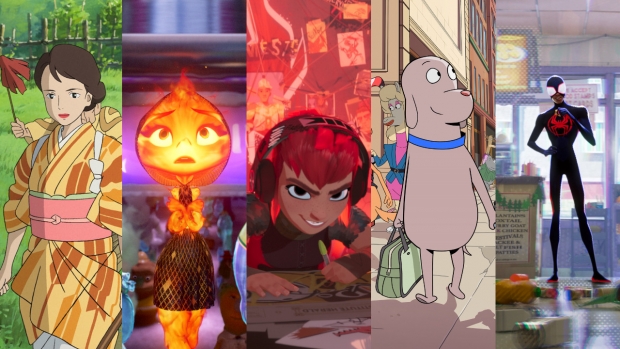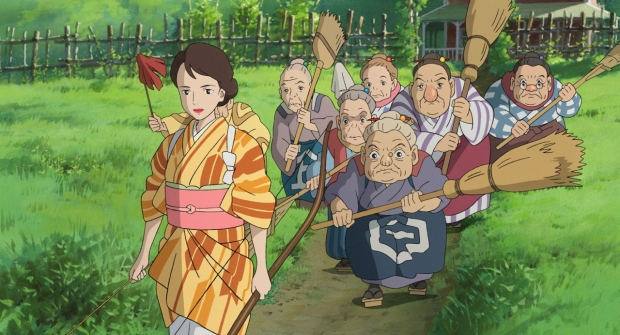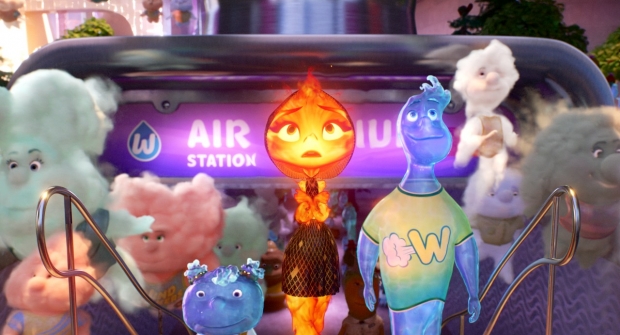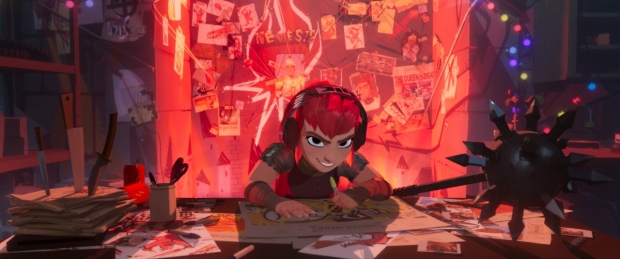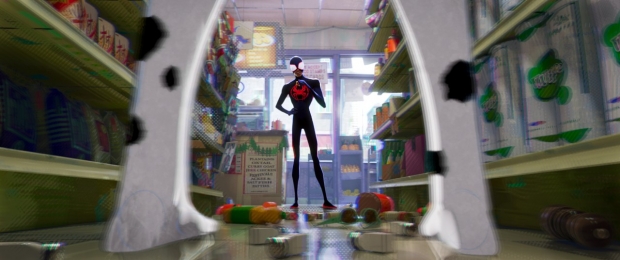Take a deeper look at ‘The Boy and the Heron,’ ‘Elemental,’ ‘Nimona,’ ‘Robot Dreams,’ and ‘Spider-Man: Across the Spider-Verse,’ all vying for the Best Animated Feature Oscar at the 96th Academy Awards coming March 10, 2024.
With just a couple days left for Academy voters to choose this year’s Best Animated Feature, the five contenders truly represent the industry’s crème de la crème. Though many deserving films didn’t make the cut – The Peasants and Teenage Mutant Ninja Turtles: Mutant Mayhem, just to name two – it’s exciting to see a wide range of stories and styles represented by this year’s nominees.
From independent animations like Pablo Bergers Robot Dreams and Hayao Miyazaki’s revival film The Boy and the Heron, to films like Elemental and Nimona, which both survived personal and industry-related losses, “resilience” seems an apt theme for this year’s nominee list. And let’s not forget Spider-Man: Across the Spider-Verse, which pushed out even further the seemingly impossible feats of visual magic its predecessor, Oscar-winning Spider-Man: Into the Spider-Verse achieved in 2018.
Before Oscar voting wraps at 5 p.m. PT on Tuesday, February 27, let’s look at each of the five worthy nominees… though we’ll have to wait until March 10 for the winner to be crowned. You can find the complete list of nominees here.
The Boy and the Heron
Originally titled How Do You Live? (Kimitachi wa Dō Ikiru ka) and inspired by a book gifted to him by his mother, Hayao Miyazaki’s film The Boy and the Heron is a semi-autobiographical story that follows character Mahito Maki, still yearning for his deceased mother as his father attempts to give them all a new life with Natsuko, Mahito’s mother’s younger sister. Though Natsuko attempts to bond with Mahito in their new country home, the boy’s grief leads him to retreat into solitude and self-harm. That is, until a talking heron beckons Mahito to an abandoned tower at the edge of the estate, noting that his mother is “awaiting your rescue.”
A Studio Ghibli production, written and directed by Miyazaki, produced by Toshio Suzuki, and distributed by Toho and GKIDS, The Boy and the Heron is the Oscar-winning Spirited Away director’s first film he wrote and directed 2013’s The Wind Rises. It also marks the director’s first attempt at dark comedy, with much of the film a blend of witty humor and violence, whether just implied or actually shown on screen.
Now a BAFTA, Golden Globe, and Annie Awards winner, The Boy and The Heron makes its way to the Oscars.
Read More:
- Hayao Miyazaki’s Triumphant Return with ‘The Boy and the Heron’
- Watch: Studio Ghibli Co-founder Toshio Suzuki Talks ‘The Boy and The Heron’
Elemental
Nominated for six Annie Awards and five VES Awards in addition to its Oscar nomination, Elemental steams ahead on its awards season run. The film follows fire element character Ember, the child of two immigrant parents, as she navigates the pressure of her father’s expectations to take over the family business while at the same time yearning to pave her own path in life. And when she falls for water element building inspector Wade, things become infinitely more complicated.
Directed by Peter Sohn and produced by Denise Ream, Elemental survived considerable challenges above and beyond those normally faced by a Walt Disney and Pixar Animation Studios film of this size. There was harsh criticism by reviewers following the theatrical release, and while no director likes negative reviews, for Sohn, this was especially heartbreaking. The film is inspired by Sohn’s own experiences coming from a family of immigrants and marrying outside of the culture; it’s a story also shared by many artists on the film, and certainly many families that ultimately enjoyed it in theaters. But the film’s path to the Oscars was anything but smooth. The production was mired in challenges, including the tremendous difficulty of animating element characters that didn’t scare the life out of children, and worries about telling an immigrant story that resonated with but didn’t offend audiences, plus the added pressure of following the studios’ disappointing Lightyear release from the previous summer. On top of which Sohn’s parents both passed away during production.
But Sohn held fast in his belief the film would find an audience, and with box office legs, especially internationally, indeed it has. And that’s why Sohn calls Elemental, “The Little Film That Could.”
Read More:
- ‘Elemental’: The Little Film That Could
- It’s ‘Elemental,’ My Dear Ember
- The Natural Chemistry of Disney-Pixar’s ‘Elemental’
Nimona
Released on Netflix, produced by Annapurna Animation, with animation and visual effects from DNEG Animation, Nimona follows the redemptive journey of knight Ballister Boldheart, framed for a murder he didn't commit and hunted by fellow knight and boyfriend, Ambrosius Goldenloin. In this futuristic dystopian world, where technology has progressed, but society has stagnated into medieval classism, the only one who can help Ballister prove his innocence is Nimona, a mischievous teen who happens to be a shapeshifting creature who can transform from a giant whale to a tiny armadillo. She’s also one of the “monsters” Ballister has previously sworn to destroy in protection of the realm.
The Annie Award-winning film, directed by Nick Bruno and Troy Quane and produced by Karen Ryan, Julie Zackary, and Roy Lee, is based on a 2015 graphic novel of the same name by ND Stevenson. Creating a story that unpacks themes of perception, expectation, and acceptance in a way that both young and older audiences will understand and find entertaining is complicated. These topics, distilled in specific ways that work when targeted towards preschool, older kids, or adult audiences, are rarely tackled in a single film that speaks to all age ranges. It’s even rarer for them to be presented with the message that acceptance of others isn’t a requirement, but rather, fair consideration. The film also infuses as many visual metaphors as possible, with color, shapes, textures, and, most prominently, the use of light and shadow, to draw the audience into the story.
But Nimona wasn’t just a complicated project. It was also a rescue project. Nimona was originally in production at Blue Sky Studios, the studio behind the hugely successful Ice Age and Rio franchises. The studio became part of Disney after its 2019 Fox purchase; it was unfortunately shut down in the spring of 2021 while Nimona was well into production. The producers scrambled to shop the film, and in true Hollywood fashion, Ted Ty, Global Head of Character Animation for DNEG, saw the story reels, Annapurna took a hard look… and in spring 2022, it was announced that the film had been saved and would get a 2023 release on Netflix.
Read More:
- Shedding Light on ‘Nimona’s Shadow Metaphors
- Revelations on Storytelling and Non-Conformity: ND Stevenson Talks ‘Nimona’
- Netflix Drops ‘The Art of Nimona’ Featurette
- Re-VIEW: ‘Nimona’ - Fluidity is Life
Robot Dreams
Directed by Spanish filmmaker Pablo Berger and inspired by Sara Varon’s book of the same name, Robot Dreams is set in New York City, sometime in the 1980s. In the film, made without dialogue, a lonely dog spots a TV ad selling a robot companion and immediately orders it. After putting the robot together, the pooch and his new bud head out and explore the city, encountering life, music, companionship, and joy that had been missing from the dog’s life until then. During a pleasant visit to Coney Island, Robot dries up, becomes paralyzed, and gets stuck on the beach. Dog is sadly forced to leave Robot there until the beach re-opens in the summer. As the seasons pass, Dog tries to find new friends, while Robot lies on the beach with his dreams. Will the previously inseparable friends ever find each other again?
Berger, who produced the Annie Award-winning film alongside Ibon Cormenzana, Ignasi Estapé, Sandra Tapia, and Jérôme Vidal, is primarily a live-action filmmaker known for experimenting with storytelling methods in each of his films. His multi-award-winning film Blancanieves was shot entirely in a 1920s-style black and white, while Abracadabra contains aggressive camera motion and angles and Torremolinos 73 was shot in the style of a 70s camcorder. But Berger never saw himself becoming an animated film director. Not until he re-read Varon’s book, which he’d kept on a shelf for a decade and picked up again for inspiration between projects.
Produced by Arcadia Motion Pictures, Noodles Production, Les Films du Worso, RTVE, and Movistar Plus+, Robot Dreams was animated at Berger’s own pop-up studio, Lokiz Films, after a collaboration to produce at Cartoon Saloon fell apart because of the pandemic. Though the studio has disbanded since the release, it involved 100 animators in both Madrid and Pamplona offices.
Read More:
- Pablo Berger Talks His Oscar-Nominated ‘Robot Dreams’
- Neon Drops First Teaser Trailer for ‘Robot Dreams’
Spider-Man: Across the Spider-Verse
In just the first few weeks of its release last summer, Sony Pictures Animation’s Spider-Man: Across the Spider-Verse grossed more than $560 million worldwide, on its way to almost $700 million global cume, the second highest for an animated film in 2023. It was also among the best-reviewed movies of the year. The follow-up to 2018’s Oscar-winning animated feature Spider-Man: Into the Spider-Verse, which redefined what a 3DCG-animated movie could look like, has raised the ante yet again with its visual bravado and narrative innovations, while holding tight to the crucial emotional core of the story.
Directed by Joaquim Dos Santos, Kemp Powers, and Justin K. Thompson, and produced by Phil Lord, Christopher Miller, Amy Pascal, Avi Arad, and Christina Steinberg, Spider-Man: Across the Spider-Verse chronicles how, after reuniting with Gwen Stacy/Spider-Woman, Brooklyn’s neighborhood Spider-Man Miles Morales catapults across the Multiverse, where he encounters the Spider Society, a team of Spider-People charged with protecting the Multiverse’s very existence. But when the heroes clash on how to handle a new threat, Miles finds himself pitted against the other Spiders, forced to redefine what it means to be a hero so he can save the people he loves most. In addition to Sony, production companies included Columbia Pictures, Marvel Entertainment, Pascal Pictures, Lord Miller Productions and Arad Productions.
Five years ago, Sony Pictures Animation changed the game of animation forever. Requiring more than 170 animators, Spider-Man: Into the Spider-Verse was not only the studio’s largest, but equally, most ambitious feature film production ever. The film’s walk-into-a-comic art style brought together decades of different illustration styles and “Spider-Man” stories, making the most of 3DCG, 2D, noir, Japanese anime, and more. Across the Spider-Verse not only increased the production’s crew size but the sheer number of animated styles, textures, and colors featured in the film. New software tools, all designed to translate the artist’s hand onto the screen, were again created to achieve layered watercolor aesthetics, punk rock collages constantly in motion, and even deconstructed villains like The Spot.
Read More:
- Fine-Tuning the Spider-Verse: A Chat with Justin K. Thompson
- Watch Just Completed ‘Spider-Man: Across the Spider-Verse’ VFX Breakdown Reel
- Unpacking The Spot and Hobie’s Disruptive Styles in ‘Spider-Man: Across the Spider-Verse’
- ‘Spider-Man: Across the Spider-Verse’ Ups the Visual and Narrative Ante
- Re-VIEW: 'Spider-Man: Across the Spider-Verse' – A Truly Diverse Cosmos
